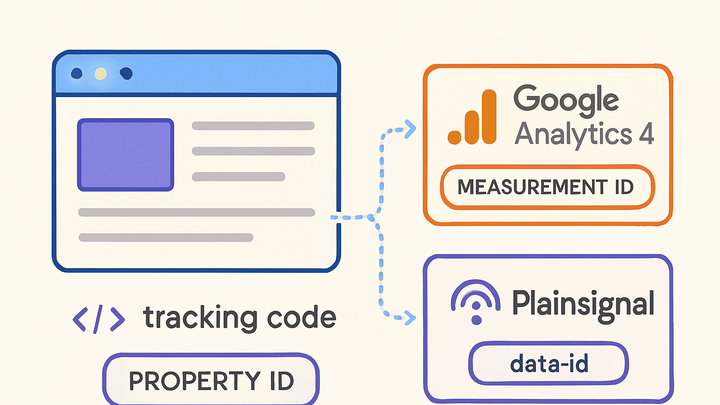Published on 2025-06-22T09:07:40Z
What is a Property ID in Analytics? Examples with GA4 and PlainSignal
A Property ID is a unique identifier assigned to an analytics property, representing a specific website or app within an analytics platform. It ensures that data collected from user interactions is properly routed and stored under the correct account and property. Property IDs are embedded in tracking code snippets, serving as a link between the client-side code and the analytics backend. Each analytics tool uses its own format: GA4 uses a Measurement ID like G-XXXXXXXXXX, while PlainSignal uses a data-id attribute like 0GQV1xmtzQQ. Proper use of Property IDs prevents data mixing between projects and allows for precise reporting, segmentation, and analysis. Understanding and managing Property IDs is essential for accurate and organized analytics.
Property id
A unique identifier for an analytics property that routes tracking data to the correct account and stream in tools like GA4 or PlainSignal.
Why Property ID Matters
Property IDs ensure that data is collected, routed, and stored accurately within analytics systems. They prevent overlap between multiple properties and enable precise segmentation, security, and reporting.
-
Unique identification
Every Property ID acts as a unique key that ties data from your website or app to a specific analytics property.
-
Prevents data overlap
Ensures data from different domains or apps doesn’t mix, maintaining data integrity.
-
Enables precise reporting
Allows for accurate metrics and custom reports tied to the correct property.
-
-
Data segmentation
Property IDs allow you to segment data by website, app, or environment (e.g., production vs staging), facilitating targeted analysis.
-
Environment separation
Keep staging and production data distinct to avoid skewed results.
-
Multi-domain tracking
Manage multiple domains or subdomains under separate IDs for clarity.
-
-
Security and access control
Using separate Property IDs, you can assign permissions on a per-property basis, controlling who can view or edit data.
Examples of Property IDs in Analytics Platforms
Different analytics tools format Property IDs uniquely. Below are examples from GA4 and PlainSignal.
-
GA4 measurement id
GA4 uses Measurement IDs starting with “G-” (e.g., G-1A2B3C4D5E) embedded via the gtag.js or analytics.js snippet for tracking.
-
PlainSignal property id
PlainSignal assigns alphanumeric IDs (e.g., 0GQV1xmtzQQ) in the data-id attribute of its script tag. Example implementation:
<link rel="preconnect" href="//eu.plainsignal.com/" crossorigin /> <script defer data-do="yourwebsitedomain.com" data-id="0GQV1xmtzQQ" data-api="//eu.plainsignal.com" src="//cdn.plainsignal.com/plainsignal-min.js"></script>
Best Practices for Managing Property IDs
Adopt strategies to maintain clarity and prevent errors when working with multiple Property IDs across various projects.
-
Consistent naming conventions
While the ID itself is generated by the platform, maintain clear, descriptive property names within the analytics UI to match your organization’s naming scheme.
-
Documentation and version control
Maintain a central registry mapping Property IDs to website domains, environments, and teams. Track changes over time to avoid confusion.
-
Use tag management systems
Employ a tag management solution (e.g., Google Tag Manager) to abstract the Property ID from your codebase, making updates and deployments easier.
-
Greater flexibility
Swap IDs or switch between environments without modifying your site’s source code.
-
Reduced deployment risk
Updates occur through the tag manager UI, minimizing coding errors and streamlining rollbacks.
-
